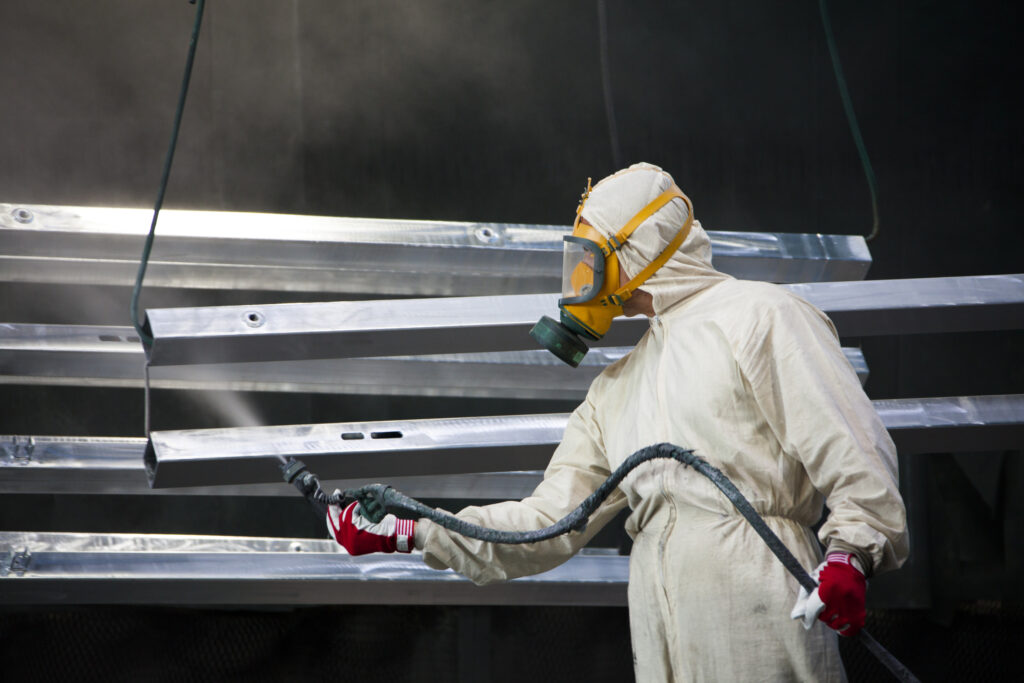Although pre-treatment of galvanized components is best carried out immediately after galvanizing, before the surface has become contaminated in any way, this is not always practical. Pre-treatment can be carried out later but it is vital that the surface is adequately cleaned to remove all traces of contaminants such as oil, grease and dirt. The cleaning operation must leave no residues on the cleaned surface and any wet storage staining should be removed using a stiff brush. Washing down the coating with water will help to remove soluble salts.
There are four recognised methods of surface pre-treatment that produce a sound substrate for paint coating:
- T-Wash (or its proprietary equivalent)
Despite the fact that this preparation process has been available for some considerable time, T-Wash is still generally considered to be the best pre-treatment method for painting galvanized steel. T-Wash is a modified zinc phosphate solution which contains a small amount of copper salts. When applied, a dark grey or black discolouration of the zinc surface will result. T-Wash must not be allowed to pool on horizontal surfaces or this will prevent maximum paint adhesion. Any excess should be removed by water. T-wash is most suitable for application to new galvanizing and should not be used on weathered galvanizing (see etch primers). Sufficient time must be allowed for the T-Wash to react and dry thoroughly before the first coat of paint is applied. (Suppliers’ information will give recommended time intervals). While research has shown that T-Washed surfaces can be left for up to 30 days before painting and good paint adhesion can still result, it is advisable to minimise the time between pre-treatment and paint application. Any white salt formed by the exposure of the T-Washed surface to moisture must be removed before painting, using a stiff brush. If the T-Washed surface has become contaminated it must be cleaned in accordance with the suppliers’ recommendations.
Constituents of T-Wash
The constituents of T-Wash are phosphoric acid (9.0%), ethyl cellusolve (16.5%), methylated spirit (16.5%), water (57.0%) and copper carbonate (1.0%). Variations to this composition may exist and so it is wise to consult the supplier if a successful result is to be achieved.
- Etch primers
Etch primers have also been used successfully. Their major disadvantage is the absence of any visible colour change as is the case with T-Wash. Therefore, there can never be complete confidence that all surfaces have reacted with the primer. Etch primers are most suited to application on older, weathered galvanizing. - Sweep blasting
A mechanical method of pre-treatment is sweep blasting using fine copper slag, J blast or carborundum powder with a blast pressure of no greater than 40psi (2.7 bar). This will ensure that only the minimum amount of oxide is removed and the zinc surface is left in a slightly roughened condition. Care should be taken when carrying out sweep blasting on very thick galvanized coatings to avoid damage to the coating. The optimum nozzle-to-work piece distance and angle of blasting needs to be identified for all surfaces on the galvanized steelwork if optimum results are to be achieved. Angular iron blasting grit must not be used under any circumstances. Sweep blasting is often used in addition to the chemical preparation stage. - Weathering
This process only becomes fully effective after a galvanized surface has been exposed to the atmosphere for a period of at least six months. The surface is prepared using either abrasive pads or a stiff brush to remove all loose adherent materials and making sure that the bright zinc surface is not restored.
This is followed by a hot detergent wash and rinsing with fresh clean water. The surface must be fully dry before any paint is applied. Weathering should not be used as a method of surface preparation in marine environments with high chloride levels.


